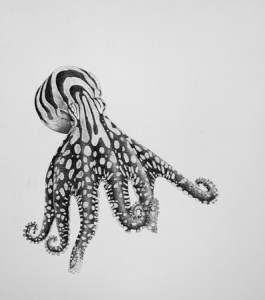
Universe of Art
[email protected] (D. Peterschmidt, Val Diaz)
How a diver and artist brought a mysterious octopus to light

How a diver and artist brought a mysterious octopus to light
Description
Octopus mating behaviors can be quite deadly. Many species are cannibalistic, making the entire prospect of mating dangerous, and female octopuses often die after laying one clutch of eggs. Their cannibalistic tendencies mean that octopuses don’t socialize as much as other animals.
But the larger Pacific striped octopus (LPSO) is different. For one, they live together in colonies. And mating is not only a safer proposition, it involves beak-to-beak “kissing.” Plus, females can lay eggs repeatedly, even tending to embryos at various stages of development.
But because these behaviors are so uncharacteristic of most octopuses, the scientific community didn’t officially recognize their existence until 2015, despite the decades-long effort of a Panamanian diver and artist named Arcadio Rodaniche. When he tried to share his findings about the LPSO at a symposium and publish them in a journal, he was flatly rejected. But his persistent research and documentation of the species would eventually be validated when researchers were able to obtain and observe the octopuses in captivity.
SciFri producer Kathleen Davis sits down with freelance science writer Kenna Hughes-Castleberry to talk about an article she reported for Science Friday about the late Rodaniche and his yearslong effort to get official scientific recognition for the LPSO.

An illustration of a larger Pacific striped octopus by Arcadio Rodaniche. Image courtesy of Denice Rodaniche.
Universe of Art is hosted and produced by D Peterschmidt, who also wrote the music and produced the original segment, along with Val Diaz. Our show art is illustrated by Abelle Hayford. And support for Science Friday's science and arts coverage comes from the Alfred P. Sloan Foundation.
Do you have science-inspired art you’d like to share with us for a future episode? Send us an email or a voice memo to [email protected].